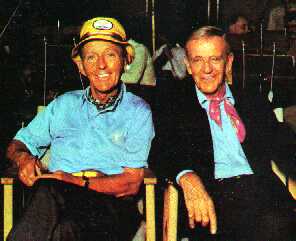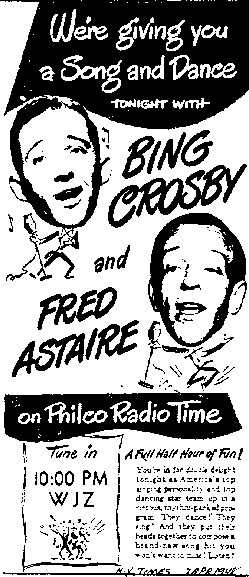
Top Billing
Virtually all the polls at the end of the 20th century placed Fred Astaire at the top or near the top of professional dancers.
Astaire made some 30 memorable movie musicals, including 10 highly-acclaimed films with co-star Ginger Rogers. The Astaire-Rogers collaboration included "The Gay Divorce," "Roberta," "Top Hat," "Follow the Fleet," "Swing Time," "Shall We Dance?," "Carefree," "The Story of Vernon and Irene Castle" and "The Barkleys of Broadway."
Astaire's success in the movies seemed as improbable as Bing Crosby's. He had a face the shape of a bartlett pear, a beanpole figure and a weak voice. In his first attempt at a movie career a Paramount executive wrote that Astaire "Can't act. Can't sing. Balding. Can dance a little." Astaire succeeded nonetheless. He sweated his way to the top. "He was a dictator who made me work harder and longer than anyone," said Nanette Fabray, one of his female costars.
 Astaire introduced 36 hit songs in his movies from 1929 through 1951. According to Joel Whitburn, author of Pop Memories, eight Astaire recordings topped the pop charts: "Night and Day," "Cheek to Cheek," "I'm Putting All My Eggs in One Basket," "The Way You Look Tonight," "A Fine Romance," "They Can't Take that Away from Me," "Nice Work If You Can Get It" and "Change Partners."
Astaire introduced 36 hit songs in his movies from 1929 through 1951. According to Joel Whitburn, author of Pop Memories, eight Astaire recordings topped the pop charts: "Night and Day," "Cheek to Cheek," "I'm Putting All My Eggs in One Basket," "The Way You Look Tonight," "A Fine Romance," "They Can't Take that Away from Me," "Nice Work If You Can Get It" and "Change Partners."
In 1942 Astaire and Crosby were paired in the Irving Berlin musical "Holiday Inn." In the movie Bing wins the girl (Marjorie Reynolds) to whom he sings what turned out to be the most successful movie song of the century, White Christmas. Bing also dances with Astaire, who later said that "Bing's the kind of dancer that I am a singer." Nevertheless, for many years Fred would answer "Bing Crosby" when asked to name his favorite dance partner -- to avoid alienating any of his female co-stars.
Astaire's best dance scene in Holiday Inn was not with Crosby but when he hot-footed alone on stage to the accompaniment of a 4th of July firecracker display. The famous scene took 38 takes during which Fred lost 14 pounds. The large number of takes were at Fred's insistance. According to Crosby: "Fred's a perfectionist .... Every step, every movement there was a firecracker let off. Some he'd throw down like torpedoes and some he'd kick-off. He had to be in certain positions all the time to hit the right firecrackers so he'd be on camera.... It was pretty elaborately contrivied and had to be done perfectly. I thought the first take he did was great. They all looked alike to me, but there was a little something he didn't like in each one. He about wore out the director and wore out the crew and the sequence took two or three days." (Thompson, pages 93-94)
 The success of "Holiday Inn" led to another Astaire-Berlin-Crosby musical called "Blue Skies" in 1946. A third collaboration of the ABC boys was supposed to be White Christmas. But when Astaire read the script he found other work. Instead, Danny Kaye was hired to fill Astaire's dancing shoes. "White Christmas" became the leading box office attraction of 1954 and a perennial Christmas holiday tradition.
The success of "Holiday Inn" led to another Astaire-Berlin-Crosby musical called "Blue Skies" in 1946. A third collaboration of the ABC boys was supposed to be White Christmas. But when Astaire read the script he found other work. Instead, Danny Kaye was hired to fill Astaire's dancing shoes. "White Christmas" became the leading box office attraction of 1954 and a perennial Christmas holiday tradition.
Astaire appeared several times on Bing's radio and TV shows through the years and they shared mutual interests in golf and horse racing. During World War II their paths crossed while entertaining the troops in Europe. At one point they feared for their safety when trapped for 45 minutes in a Glasgow railway baggage room while surrounded by 35,000 fans demanding a performance. (Crosby, 197-99)
Ken Barnes, Bing's last album producer, persuaded Bing and Fred to record an album of duets in London in 1975. Barnes later recalled the contrasting styles of the two stars:
Once the material had been decided upon, we paid only one visit to Bing's house which consisted of one hour and a half around the piano during which time Bing would sing each song through no more than twice -- once for the key and then once again for the tempo.... That solitary visit to Crosby's house was in no way comparable to the nine visits we made to Fred's house, each lasting a minimum of three hours. Whereas Crosby would approach each song in a casual, seemingly off-hand manner, Astaire went to the other extreme. He would plan each song routine as though it were an intricate piece of choreography.When Bing and Fred arrived in London in July, their contrasting styles posed a problem. According to Barnes:
I rang the Connaught and got through to Fred. His first question could not have been more direct. "What time do we meet with Bing tomorrow?" There was no beating around the bush with Astaire either and I plunged straight in. "Bing can't make it tomorrow. He's tied up all day." I waited for Fred's comment but there was only silence from the telephone. "But he'll meet you a half hour before the session," I went on, "and run down each of the songs individually."For a moment I thought we had been disconnected but after a few seconds Fred spoke and his comments about Crosby were anything but complimentary. He accused Bing of being totally irresponsible and unprofessional, but eventually, after he had got the initial anger out of his system, Fred conceded that this was Bing's way of working and it was too late to expect him to change. "But," added Fred, "it's not my way of working. It may be OK for the great Crosby to stroll into a studio and turn on the magic, but I can't work that way. I've got to rehearse with somebody." (Barnes, pages 47-53)
The Crosby-Astaire duet album turned out to be a hit. Apparently, Astaire held no grudge against Bing, for he agreed to be Bing's guest on his 1975 Christmas TV special, recorded in November. The TV special would be the last time the two worked together.
Fred died of pneumonia at age 88 in the wee hours of June 12, 1987, in a Los Angeles hospital, where he had been admitted 10 days earlier for a bad cold. His second wife, Robyn, 44, was at his bedside.
References: